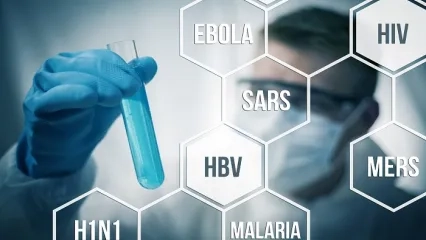Alo Yeditepe
Alo Yeditepe
Things to Consider When Touching Meat at Eid
What to Take Into Account When Touching Meat at the Feast
It is necessary to be careful when preparing and consuming meat, which is indispensable for tables, during Eid al-Adha. Infectious Disease Specialist at Yeditepe University Hospital, Prof. Dr. Meral Sönmezoğlu listed what needs to be considered during the holiday, from the selection of the sacrifice to the preparation of the meat…
Choose Between Animals That Are Under Veterinary Control
It is important to choose sacrificial animals under veterinary control in order to prevent the risks that may occur. There is a risk of transmission of many diseases such as hydatid cyst, tuberculosis, rabies, anthrax, brucellosis, salmonellosis, tapeworm, and toxoplasmosis to people who come into contact with victims who do not have the necessary health checks.
Wear Gloves When Handling Meat
Emphasizing that the place to be cut should be clean and in accordance with hygiene rules, Prof. Dr. Meral Sönmezoğlu lists the points to be considered in order to protect from disease-causing microorganisms as follows: "There should be a large area where the flowing blood does not accumulate, where its drainage is provided, where pest-free, cats, and dogs do not roam. Animals to be slaughtered should not be fed for 6-12 hours before slaughter, but only given water to drink. It is important that cutting tools such as knives and rows used in meat cutting, used containers and the hands of people who cut are clean. Also, people who come into contact with meat should work with gloves, not with bare hands. In order to prevent the transmission of disease-causing microorganisms to the meat; cutting, swimming, and breaking down the meat should be done in a cool and clean place, and the stomach and intestinal content should not be transmitted to the carcass, that is, to the body. If there is only visible contamination, the body should be washed, otherwise it should not be washed. At no stage of the cutting and swimming process should the outer face of the skin come into contact with the flesh."
Let the Meat Rest in A Cool Place First, Then Place It in the Refrigerator
There are some points to be considered after the meat of the victim is cut. Meat placed in clean containers in large pieces should be kept in a cool and clean place that does not see the sun for 5-6 hours. Then it is important to break it into small pieces and put it in the refrigerator bags and put it in the refrigerator. In addition, it is necessary to use gloves when touching the meat during all procedures.
Do Not Eat Meat Raw or Undercooked
It is recommended to consume the meat by waiting for 24-36 hours after cutting. Also, it should not be consumed raw or undercooked. It is also important to pay attention to some points during the storage of sacrificial meat. The durability of the meat is stated as +4 degrees in the refrigerator, 1-3 days in minced meat, 4-5 days in piece meats, and 6 months in the deep freezer. It is also important that frozen meats are not refrozen after thawing.
Do Not Give Internal Organs to Cats and Dogs
Emphasizing that inedible internal organs should be destroyed or buried in deep pits, Prof. Dr. Meral Sönmezoğlu said, "Care should be taken to place the organs thrown out while being buried at a depth that animals such as cats and dogs cannot remove and to pour unslaked lime on the thrown organs. This prevents both the disease of animals such as cats and dogs and the spread of diseases. Internal organs such as liver and lung should not be given to dogs and cats."
What people who will come into contact with meat during the holiday should pay attention to?
- The animals must be selected among those under veterinary control.
- The slaughter must be done by experienced butchers in hygienic conditions.
- Preventive measures have to be taken during cutting.
- If there is an injury, your health institution should apply for treatment.
- Meat should not be touched with bare hands during the storage and cooking of sacrificial animals, especially if there are previously formed scratches or wounds on the hands.
- If there are symptoms such as diarrhea, abdominal pain, fever, headache, constipation, weight loss, and night sweats after contacting or consuming meat, a health institution should be consulted.
About
Faculty and Year of Graduation:
Medical Faculty of Ankara University, 1984
”
See Also
- What is Hepatitis B? What are its symptoms? How is it Transmitted?
- What is HMPV Virus? HMPV Symptoms and Ways of Transmission
- Why Is the Flu Lasting Longer This Year?
- What Precautions Should Be Taken Against the Cold Epidemic?
- Don't Be Late Fighting Against Diseases
- Antibiotics Kill Beneficial Bacteria, Not Viruses
- What is Hepatitis? What are the Symptoms and Treatment Methods?
- Symptoms and Treatment of Tick Bites
- Summer Infections
- Precautions Must Be Taken Against Loss of Life Due To Infection in Thalassemia
- Information on H1N1 (Swine Flu)
- Summer is Coming... Beware of food poisoning!
- Our Taboos Affect the Increase in the Number of HIV-Positive Cases in Turkey
- Strep A Symptoms and Treatment
- Do Not Put a Cigarette Butt or Pour Olive Oil or Liquid Soap on the Tick
- Reheat the Food You Cooked Only Once!
- HIV Can Be Hidden for 10 Years without Any Symptoms!
- 290 Million People Live Without Knowing They Have Hepatitis
- What Is Anthrax Disease?
- The Way to Fight AIDS is to Raise Awareness First
- Still Not Too Late For Flu Vaccine
- What is Rhinovirus?
- Fighting with Thalassemia: Meral Yılmaz
- Thalassemia Spreads from the Mediterranean to the Whole of Europe with Migration!
- Early Treatment of Crimean Congo Hemorrhagic Fever is Vital
- Approximately 3 Million Patients Need Blood Transfusions Every Year in Turkey
- When to Get the Flu Vaccine
- Antibiotics Account For 14% of Prescription Costs
- West Nile Virus Replaces Malaria
- It Is Necessary to Try to Be Healthy in order to Be Protected
- A New Flu Outbreak is Expected Every 10 Years
- 63% of Vector-Borne Diseases are Caused by Lyme Disease
- Experts Warn About Flu Risk
- Mosquito Infection Risk
- Why aren’t Antibiotics Working Any More?
- The World Raises an “Alarm” on Antibiotic Resistance!
- What is COVID-19?
- The Mask Requirement was Removed and the Importance of Social Distance Increased!
- How to Prevent COVID-19 in School-Going Children
- WHO (World Health Organization) Warns for Antibiotic Resistance!
- Who Is Threatened by Monkeypox?
- Ways to Prevent Coronavirus
- Swine Flu / H1N1
- Life Returns to Normal with Caution
- What is Monkeypox Virus? What Are the Symptoms of the Monkeypox Virus?
- What is Lyme Disease?
- How to Tell if You Have a Mild Coronavirus?
- Pay Attention to These Rules for COVID-19
- Hand Sanitizer Usage Guide
- The Priority Rule for the Protection from Summer Infections is Hygiene
Alo Yeditepe




